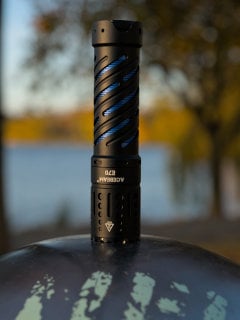For background, it’s hard to make a flashlight that works well on both AA batteries (0.8-1.7V potential operating range) and 14500 Li-ion batteries (2.8-4.2V operating range) given that white LEDs need about 3V.
For a long time, companies would make lights designed for AA using a boost driver that increases the output voltage, do just enough so it wouldn’t burn out with excessive input voltage, and say that 14500 size Li-ion was “supported”. Max output would, indeed be brighter, but low modes were usually far too high, and the flashlights could easily damage batteries that didn’t have over-discharge protection.
The Skilhunt M150 was one of the first lights to do a substantially better job. Using a Li-ion battery, it sent the power through a variable-output linear regulator so both battery types could have reasonable modes, and it would shut off to prevent over-discharge. Several competitors use a similar approach today, but linear regulators are inefficient; they just turn the excess voltage to heat.
The ideal solution is either to use a higher-voltage LED configuration and boost the output voltage for both battery types, or to use a driver that can both boost (increase) and buck (decrease) voltage efficiently. The Emisar D3AA is the only light on the market doing AA/14500 with a high-voltage LED configuration (three in series for ~9V), and I believe the new M150 will be the first one using the buck/boost approach (though it’s possible Zebralight has done it in the past).
Nice. But it’s time for Skilhunt to board the Anduril bus ;).
I’m not sure that’s the right fit for Skilhunt, or at least the M150. It might be good on something like the EC200S.
Well, you know Skilhunt’s product line better than I do, but the M150 sure looks like an Anduril light to me, except for running the wrong software :). I do like the good support for dual fuel. 14500-only seems like an annoying format, since a 14500 or AA is about the same volume as a 16340, so they might as well make a 16340 light, or else an 18350/18650 dual fuel with swappable battery tubes. That said, I got a Wurkkos HD10 recently and it is nice.
I want an M150-shaped Emisar also. That’s for a different audience though.
14500 or AA is about the same volume as a 16340, so they might as well make a 16340 light
14500 has more capacity and allows a slimmer flashlight. Not enough lights lean in to the diameter advantage.
14500 vs 16340 capacities are pretty close if not equal, and 18350 surely exceeds 14500. I’ll measure diameter when I get home, but I don’t know of any 14500 light as thin as some of my CR123A (16340 sized) lights. I mean they could, but they don’t. Anyway the 2mm isn’t really significant imho. Small CR123A lights are perfectly pocketable, and we shouldn’t forget 10440/AAA if we want tiny lights. Now if only someone made an Anduril one. I still have to make another attempt fixing my Skilhunt E3A…
Added: it would be great if Skilhunt would make an AA version of the E3A. One level of about 100 lumens. No microprocessor and not too much lumenitis.
14500 vs 16340 capacities are pretty close if not equal
Not even close. 16340s top out at 950 mAh while 14500s are up to 1500 advertised and pretty close to that tested.
18350 surely exceeds 14500
Yes, by about 100 mAh.
I don’t know of any 14500 light as thin as some of my CR123A (16340 sized) lights
Here are 30 1x14500 lights under 20mm in diameter. There are no 16340 lights that slim; the search offers the Fenix LD15R, but I think that’s a mistake.
I was very skeptical of that claim of 1500mah for a 14500 but if testing confirmed it, then ok hmm. Most 14500 cells I see are around 900mah, similar to 16340.
It looks like the Quark CR123A Mini is spec’d at 0.80 inch diameter which is 20.32mm. That’s the light that I was going to measure at home. They also made a CR2 version that might be a little thinner, but that gets obscure.
That’s interesting about the thin 14500 lights, particularly the Emisar D2 which is dual fuel and runs Anduril. I might get one sometime. I was sort of tempted by it but got the Wurkkos HD10 instead recently, since it has USB charging, is maybe less fussy about battery length, plus was cheaper.
Fwiw the long lamented Arc AA had 0.725" diameter, or 18.4mm. I sold mine many years ago, for about twice what I paid for it iirc.
At one point I decided that AAA was the best format for small lights, and I still have a sizeable collection of them. Most use 5mm leds so are technologically out of date by today’s standards.
I’m trying to stop worrying about battery capacity for rechargeables, within reason. It just means you recharge a little bit more or less often.
Skilhunt has really shitty customer service. They sold me a flashlight with a broken charger and refused to replace it.
I don’t believe they read the comments here, but if you post a response about that issue in the BLF thread I linked, that might get their attention.
I gave them every opportunity to do the right thing. I’m only trying to warn others.



